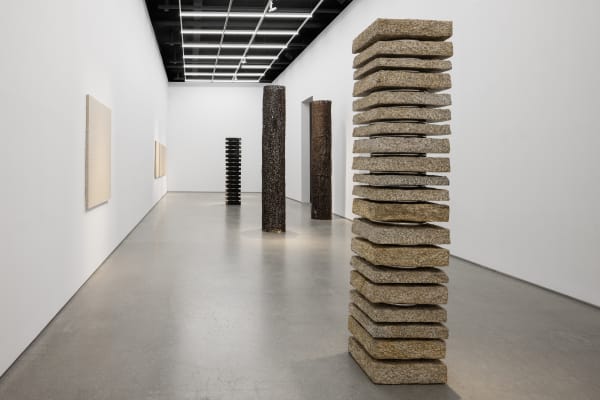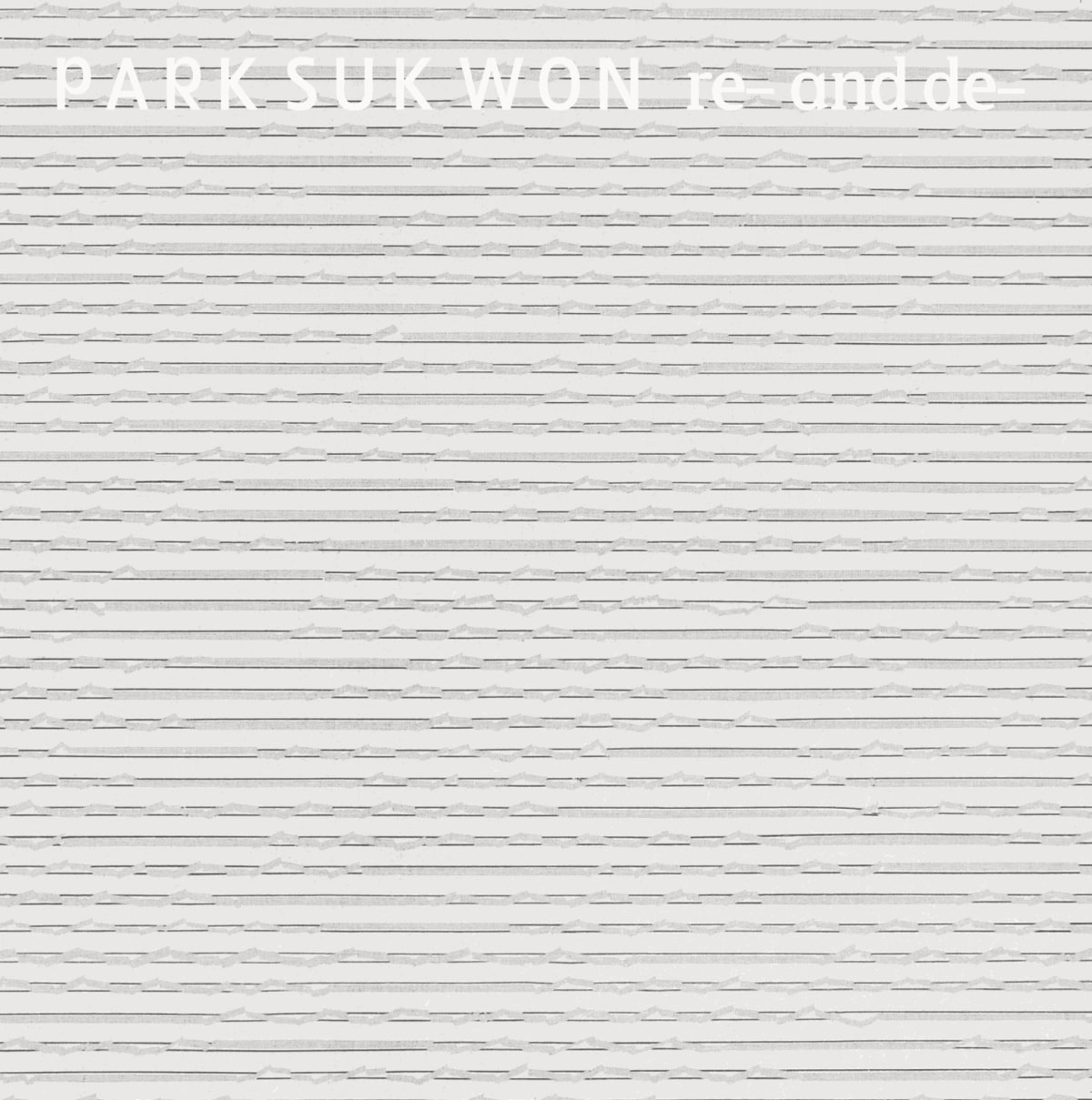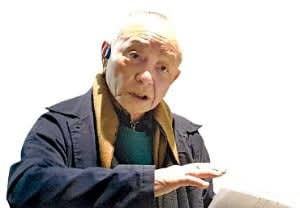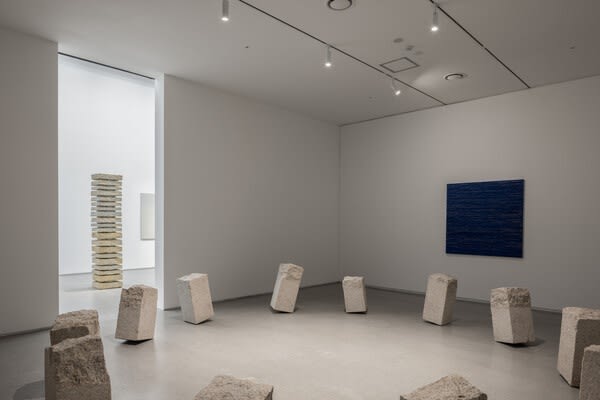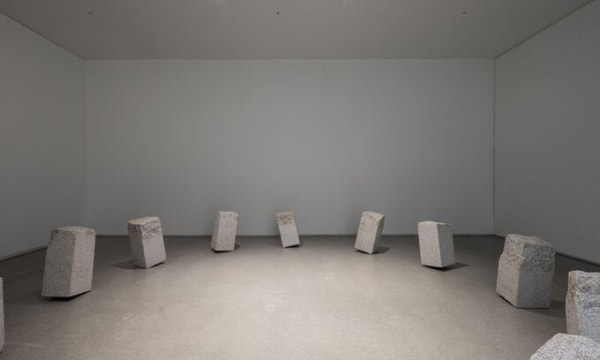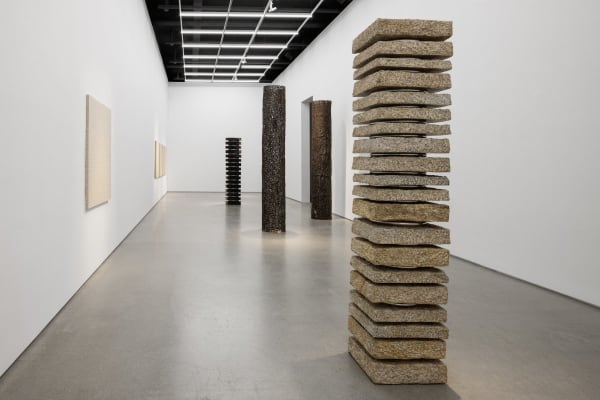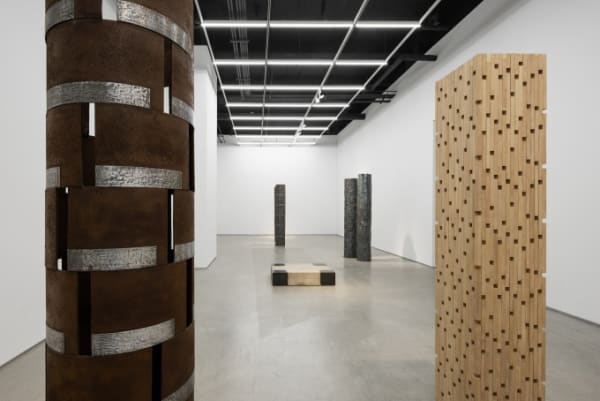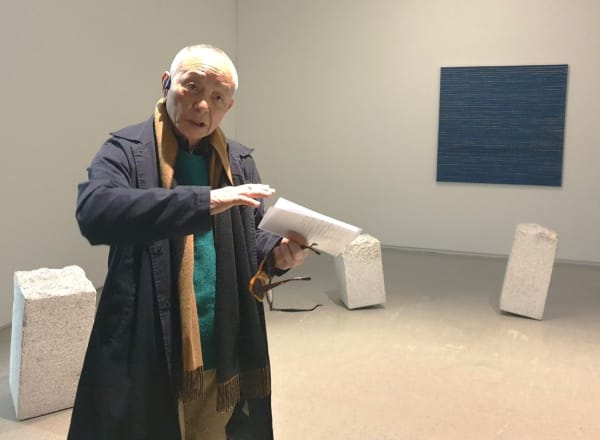PARK SUK WON Korean, b. 1942
Park Suk Won (b.1942) is a leading figure in the history of Korean contemporary sculpture. As a part of a founding member of the Korean Avant-Garde Group (AG, 1969-1975), he participated in the 5th Paris Biennale (1966) and the 10th Sao Paulo Biennale (1969). His works are held in the collections of prominent museums, National Museum of Modern and Contemporary Art (MMCA, Korea), Daegu Art Museum (Korea), and Walkerhill Museum, among others.
Park Suk Won’s Accumulation series is an examination of the potentiality of an oeuvre, hence seeking harmony between men and nature. Throughout the Accumulation series from the 1980s, employing the method of “abstract-cutting” and “accumulation,” he has prominently worked with nature-based materials such as stones and wood.
In pursuit of an unorthodox approach to his work, Park Suk Won has kept his distance from handed-down techniques. His methodology built a new flow of Korean abstract sculpture. In the absence of any representational image, he immerses himself in a simplified and abstract form of a sculpture, leading to the question of the existence of men.
The core concepts of “accumulation” and “repetition” also expand in Park Suk Won’s two-dimensional works. Embracing the tendency of natural resources or materials, he aggregates the Korean traditional paper, “Hanji,” vertically and horizontally on a canvas. Through the practice of repetition and re-assembly, he once again underlines the value of the pure properties of materials while expanding his philosophy to two-dimensional paintings.
박석원 (b,1942)은 한국현대조각사를 대표하는 작가이다. 1969년도 부터 한국 아방가르드 협회(AG)로 활동하며, 1975년 현대미술운동의 일환으로 시작된 ‘에꼴 드 서울’ 전시에 참여해 한국 화단의 새로운 조형질서를 모색했다. 제 5회 파리 비엔날레, 제 10회 상파울루 비엔날레, 제1회 시드니 비엔날레에 참여하였으며, 현재 그의 조각은 국립현대미술관(서울), 서울시립미술관(서울), 아테네 자유공원시립예술센터 (그리스), 산투티르수 조각공원 (포르투갈) 등 유수 기관에 소장 되어 일상 생활공간에서 대중과의 만남을 통해 현대조각의 인식을 넓히고 있다.
한국의 돌탑이 지닌 조형적인 특성을 현대 추상조각으로 연결 지어 한국적인 추상조각의 방향을 모색한 그의 의지는 한지라는 소재를 통해 발전한다. 축적과 반복의 개념은 기하학적으로 절단된 한지를 수평 수직으로 중첩시킨 평면으로 확장되며 구체적인 형상을 나타내기 위한 매개체가 아닌 한지 자체의 물성을 강조한다. 이는 재료를 절단하고 재조립함으로써 본연의 물성을 드러내는 조각적 태도의 연장선이며, 조각가로서 물질을 입체적으로 바라보고 그것을 분화하는 본능이 평면작업으로 확장되었음을 알 수 있다.
-

Growing: Park Suk Won, Choi Insu, Yoon Sang Yuel
4 - 20 Apr 2024Growing Park Suk Won Choi Insu Yoon Sang Yuel 4 - 20 April 2024 Gallery 3, Frieze No. 9 Cork Street, London The Page Gallery is delighted to present a...Read more -

Park Suk Won: Re- and De-
11 Jan - 2 Mar 2024The Page Gallery is delighted to present < Park Suk Won: re- and de- > , a solo exhibition by a leading figure of abstract sculpture, Park Suk Won (b.1942),...Read more
-

A Korean Gallery Seeks to Expand Its Reach
The New York Times February 29, 2024By David Belcher Reporting from Seoul Feb. 29, 2024 In the Seongdong neighborhood of hipster bars and pedestrian streets crowded with the well heeled, the...Read more -

조각가 박석원 "쌓고 부수고 다시 쌓고 부수면서 겸허와 겸손을 배워요"
한국경제 January 22, 2024원로 조각가 박석원(82·사진)의 초기 화두는 ‘절단’이었다. 작가는 6·25전쟁의 상처가 채 아물기 전인 1960년대에 20대를 보냈다. 전쟁 직후 한국 사회가 품었던 시대적 상실감을 철 용접의 방식으로...Read more -

더페이지갤러리, 박석원 작가 개인전 ‘비유비공 非有非空’
여성조선 January 22, 2024한국 추상조각의 거장인 박석원 작가의 개인전. 1980년대 전후로 시작된 ‘적의(積意)’ 시리즈를 중심으로 조각뿐만 아니라 평면작업까지 다양한 작품으로 구성, 작가의 폭넓은 예술 세계를 만나볼 수 있는...Read more -

有와 無 사이 중도에 사물의 본성 켜켜이
세계일보 January 18, 2024비유비공(非有非空). 실상은 있지도 아니하고 없지도 아니한, 유(有)와 무(無)의 중도라는 뜻이다. 어느 한 곳으로 치우치지 않는 작가 박석원의 조각이 이와 닮아있다. 1980년대 전후로 시작된 그의 ‘적의(積:...Read more -

돌… 나무… 한지… 자르고 또 쌓고
동아일보 January 16, 2024한국의 돌탑에서 영감을 얻어 ‘쌓기’ 중심의 조각 작품을 선보여 온 박석원(82)의 개인전 ‘비유비공(非有非空)’이 서울 성동구 더페이지갤러리에서 11일 개막했다. 이번 전시는 1980년대 전후로 시작된 작가의 ‘적의(積意)’...Read more -

있지도,없지도 아니한 '비유비공'의 세계‥박석원의 무한쌓기를 만난다
뉴스핌 January 15, 2024[서울 뉴스핌]이영란 편집위원=한국 현대 추상조각계의 중추적 작가 박석원(b.1942)이 서울숲의 더페이지 갤러리(대표 성지은)에서 개인전을 개막했다. 있지도 아니하고, 없지도 아니하다는 뜻의 '비유비공 非有非空'이란 제목으로 1월 11일 막을...Read more -

반복·증식하는 철과 돌·나무…원로조각가 박석원 개인전
연합뉴스 January 15, 2024'반복'과 '증식'을 화두 삼아 미니멀리즘 추상조각 작업을 해온 원로 조각가 박석원(82)의 개인전 '비유비공'전이 서울 성수동 더페이지에서 열리고 있다. 1960∼1970년대 철 용접 방식으로 앵포르멜(비정형 미술) 작업을...Read more


